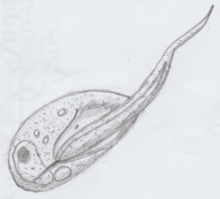Apusomonadida
| Apusomonadida | |
|---|---|
 | |
| Apusomonas sp. | |
| Scientific classification | |
| Domain: | Eukaryota |
| (unranked): | Obazoa |
| Class: | Thecomonadea |
| Order: | Apusomonadida Karpov & Mylnikov, 1989[1] |
| Genera | |
The Apusomonadida are an taxonomic group of protozan zooflagellates, that appear to be the sister group to the Opisthokonts. Together with the Breviatea, these form the Obazoa clade.[2][3][4]
It includes the genera Apusomonas, Amastigomonas, Manchomonas, Thecamonas, Podomonas and Multimonas. There is an effort to clarify the relationships between these genera.[5]
Taxonomy
- Class Thecomonadea Cavalier-Smith 1993 stat. n. 1995 emend. 2012[6]
- Order Apusomonadida Karpov & Mylnikov 1989
- Family Apusomonadidae Karpov & Mylnikov 1989
- Genus Amastigomonas de Saedeleer 1931
- Species A. borokensis
- Species A. caudata Mylnikov 1989
- Species A. debruynei de Saedeleer 1931
- Genus Chelonemonas Heiss et al. 2015
- Species C. geobuk Heiss et al. 2015
- Species C. masanensis Heiss et al. 2015
- Genus Manchomonas Cavalier-Smith 2010
- Species Manchomonas bermudensis (Molina & Nerad 1991) Cavalier-Smith 2010 [Amastigomonas bermudensis Molina & Nerad 1991]
- Genus Apusomonas Alexeieff 1924
- Species A. australiensis Ekelund & Patterson 1997
- Species A. proboscidea Alexeieff 1924 [Rostromonas applanata Karpoff & Zhukov]
- Genus Multimonas Cavalier-Smith 2010
- Species M. media
- Species M. marina (Mylnikov 1989) [Amastigomonas marina (Mylnikov 1989)]
- Genus Thecamonas Larsen & Patterson 1990
- Species T. trahens Larsen & Patterson 1990 [Amastigomonas trahens (Larsen & Patterson 1990) Molina & Nerad 1991; Rhynchomonas nasuta]
- Species T. filosa [Amastigomonas filosa (Larsen & Patterson 1990)]
- Species T. muscular [Amastigomonas muscula Mylnikov 1999]
- Species T. mutabilis (Griessmann 1913) Larsen & Patterson 1990 [Rhynchomonas mutabilis Griessmann 1913; Amastigomonas mutabilis (Griessmann 1913) Patterson & Zölffel 1993]
- Species T. oxoniensis
- Genus Podomonas Cavalier-Smith 2010
- Species P. magna
- Species P. capensis
- Species P. griebenis (Mylnikov 1999) [Amastigomonas griebenis Mylnikov 1999]
- Species P. gigantea (Mylnikov 1999) [Amastigomonas gigantea Mylnikov 1999]
- Species P. klosteris (Arndt & Mylnikov 1999) [Amastigomonas klosteris Arndt & Mylnikov 1999]
- Genus Amastigomonas de Saedeleer 1931
- Family Apusomonadidae Karpov & Mylnikov 1989
- Order Apusomonadida Karpov & Mylnikov 1989
References
| Wikispecies has information related to Apusomonadida |
- ↑ Karpov S. A. & Mylnikov A. P. 1989. Biology and ultrastructure of colourless flagellates Apusomonadida ord. n. Zoologischkei Zhurnal 58: 5-17. (in Russian)
- ↑ Thomas Cavalier-Smith & Ema E. Chao (October 2010). "Phylogeny and evolution of Apusomonadida (Protozoa: Apusozoa): new genera and species". Protist. 161 (4): 549–576. doi:10.1016/j.protis.2010.04.002. PMID 20537943.
- ↑ Brown, Matthew W.; Sharpe, Susan C.; Silberman, Jeffrey D.; Heiss, Aaron A.; Lang, B. Franz; Simpson, Alastair G. B.; Roger, Andrew J. (2013-10-22). "Phylogenomics demonstrates that breviate flagellates are related to opisthokonts and apusomonads". Proceedings of the Royal Society of London B: Biological Sciences. 280 (1769): 20131755. doi:10.1098/rspb.2013.1755. ISSN 0962-8452. PMC 3768317. PMID 23986111.
- ↑ Eme, Laura; Sharpe, Susan C.; Brown, Matthew W.; Roger, Andrew J. (2014-08-01). "On the Age of Eukaryotes: Evaluating Evidence from Fossils and Molecular Clocks". Cold Spring Harbor Perspectives in Biology. 6 (8): a016139. doi:10.1101/cshperspect.a016139. ISSN 1943-0264. PMC 4107988. PMID 25085908.
- ↑ Torruella, Guifré; Moreira, David; López-García, Purificación (2017). "Phylogenetic and ecological diversity of apusomonads, a lineage of deep-branching eukaryotes". Environmental Microbiology Reports. 9 (2): 113–119. doi:10.1111/1758-2229.12507.
- ↑ CAVALIER-SMITH, Thomas (May 2013). "Early evolution of eukaryote feeding modes, cell structural diversity, and classification of the protozoan phyla Loukozoa, Sulcozoa, and Choanozoa". European Journal of Protistology. 49 (2): 115–178 Document online. doi:10.1016/j.ejop.2012.06.001. ISSN 0932-4739. PMID 23085100.
This article is issued from
Wikipedia.
The text is licensed under Creative Commons - Attribution - Sharealike.
Additional terms may apply for the media files.